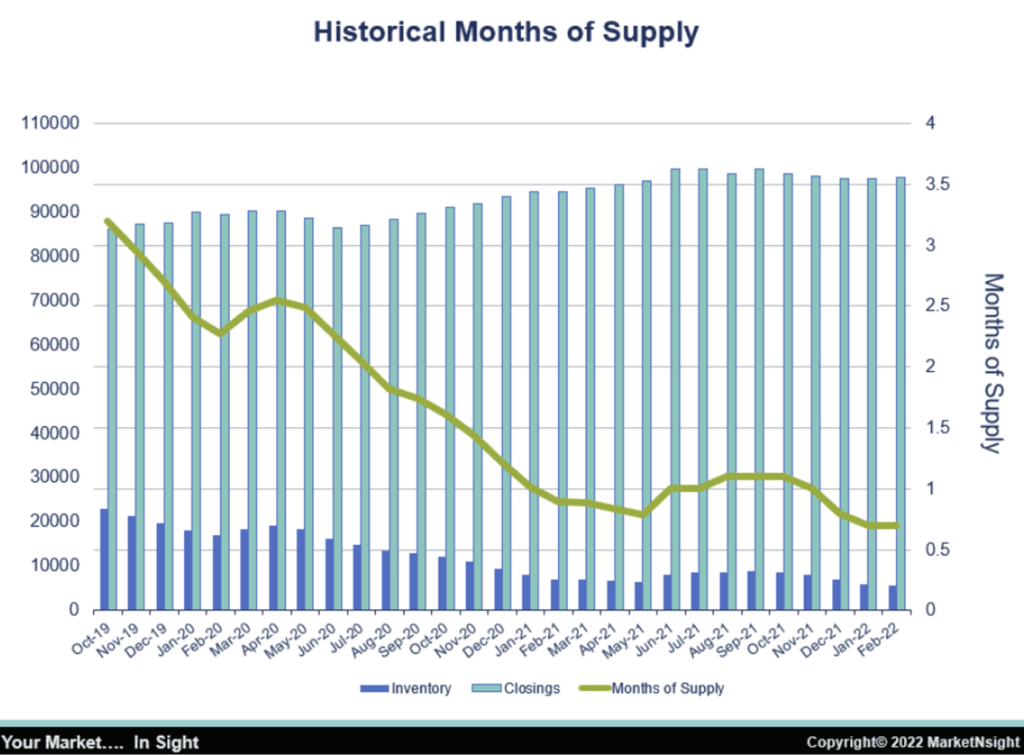In the past, there was a direct correlation between rising interest rates and declining housing demand, but that was then, and this is now. In the post-pandemic world of home-buying, demand has continued to climb in the midst of current inflationary cost increases, rising interest rates, low inventory, and decreased affordability.
In a recent MarketWatch webinar, speakers John Hunt, president of MarketNsight, and Dr. Rajeev Dhwan, director of the Georgia State Economic Forecasting Center, discussed the outlook of the market in 2022 and beyond.
Though demand remains strong, returning to normalcy after the pandemic has occurred in a two-step-forward, one-step-back manner, according to Dr. Rajeev Dhawan. Economic progress in 2022 hinges on multiple variables including interest rate increases by the Federal Reserve, geopolitics with oil price sensitivity to Russia-Ukraine tensions, and supply chain shortages due to COVID lockdowns in China.
In the past few months, the stock market volatility has made indexes flirt with a bear market, that have halted rapid home price appreciation, and supply chain issues have led to inflation being more than triple the rate in late 2020. According to the Wall Street Journal, record home prices and higher mortgage rates in May made it the most expensive month since 2006 to buy a home. Increasing interest rates and affordability have resulted in a slight cooling of the housing market with housing starts and sales decreasing in May; however, economist suggest that there is not enough inventory to crash the market, even if costs remain high.
According to a recent MarketWatch report, recent market drivers have taken the market to a place it has never been before. The metro Atlanta area needs 90,000 more homes over the next year to meet housing demand and get back to a normal six-month supply of inventory, rather than the current zero months of inventory.
At the end of 2019, millennials, “the sleeping giant,” began synchronously buying houses and following the pandemic-related shutdowns in 2020, they picked back up where they left off. The new need for larger, more flexible spaces, in combination with the desire to move outside of metropolitan areas, created an unexpected explosion in demand for homes.
In only 12 months, from May 2020 to May 2021, the housing market went from just over three months of supply to 0.7 months of supply. As of February 2022, we are still at 0.7 months of supply which shows a severe supply deficit and points to a future of continued supply shortages (Figure 1). In Georgia, forecasters have seen demand remaining constant as builders steadily acquire an increasing number of housing permits in areas such as Macon, Augusta, and Savannah to keep up with the housing boom in our state.

“We have never been here before,” Hunt said. “Zero inventory is a huge game-changer. The demand is so high above our ability to supply that any effect from rising interest rates will probably be muted.”
Recent reports have cited a decrease in housing starts as interest
What about the lumber prices?
Amid the demand for housing with surging mortgage rates and crippling inflation, declining prices for finished softwood lumber should also offer some relief since prices have been plummeting since late February.
In mid-June, Forest2Market reported that prices for southern yellow pine lumber had dropped 60% from the peak reached in early March of this year. As a result, many producers are plagued with concerns about: 1) whether the market is becoming overproduced and 2) the outcome if demand falls for a more prolonged time period.
As technology-driven, low-cost production increases, lumber prices seek a floor and the excess supply of lumber will drive high-cost producers out of the market. As illustrated in Figure 2 below, lumber producers have been chasing a moving target while carefully balancing inventories and costs for over two years. This trend is difficult for manufacturers to manage, especially in current economic conditions, and the FED’s reactionary efforts to drive desired outcomes will likely lead to the housing and lumber markets remaining unaligned in the future.

According to Forest2Market, the North American softwood lumber market remains highly volatile, and the sawmill industry is being forced to react and evolve quickly. Finished lumber prices have demonstrated tremendous fluctuations during the last 12 months, moving from over $1,000/MBF to under $600/MBF — a decrease of nearly 60 perccent — not once, but twice.
Visit www.MarketNsight.com to learn more about the firm’s housing market and economy expertise, how MarketNsight gives home builders the best information on where to build in more than 30 cities across the Southeast.
Visit https://www.forest2market.com/ to learn more about news on timber pricing, cost benchmarks, and in-depth analytics for participants in the wood raw materials supply chain.


